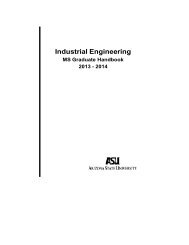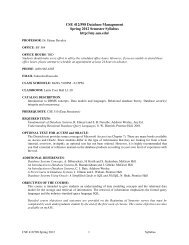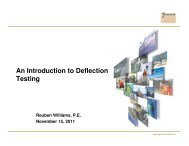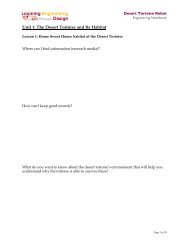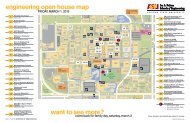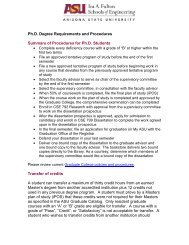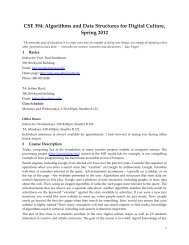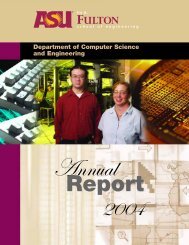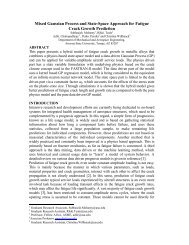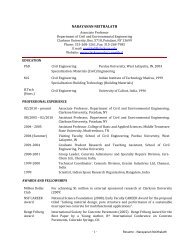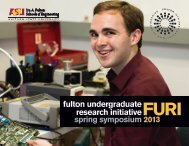Abstract Book - Ira A. Fulton Schools of Engineering - Arizona State ...
Abstract Book - Ira A. Fulton Schools of Engineering - Arizona State ...
Abstract Book - Ira A. Fulton Schools of Engineering - Arizona State ...
Create successful ePaper yourself
Turn your PDF publications into a flip-book with our unique Google optimized e-Paper software.
Integrated Fiber-Wireless (Fi-Wi) Access Network: Simulation and Validation<br />
Omar H. Habib, Electrical <strong>Engineering</strong><br />
Graduation: May 2010 Hometown: Phoenix, <strong>Arizona</strong><br />
Mentor: Dr. Martin Reisslein, Electrical <strong>Engineering</strong><br />
Grand Challenge: Enhance virtual reality<br />
The overall goal <strong>of</strong> this research project is to stimulate the performance <strong>of</strong> fiber-wireless (FiWi) networks in a<br />
very wide spectrum including the design, packet transmission, coding and decoding techniques, and algorithms.<br />
CSIM and omnet++ network simulators have been used to stimulate, and verify the performance <strong>of</strong> the EPON<br />
and wireless network configuration. Future work will analyze network delay and stability. Discrete and continuous<br />
data frames will be examined using the help <strong>of</strong> the mathematical models and equations. Developing a code to<br />
use both simulators simultaneously will be considered as well.<br />
Quantitative Assessment <strong>of</strong> the Effects <strong>of</strong> Endovascular Therapies on<br />
Cerebral Aneurysm Fluid Dynamics: an In-Vitro Flow Study<br />
Walter Hafner, Bioengineering<br />
Graduation: May 2011 Hometown: Snowflake, <strong>Arizona</strong><br />
Mentor: Dr. David Frakes, Bioengineering<br />
Grand Challenge: Biological and human systems<br />
The rupture <strong>of</strong> a cerebral aneurysm, a serious medical emergency, carries a 50% mortality rate. This study aims<br />
to quantitatively assess the effectiveness <strong>of</strong> embolic coils and stents in mitigating aneurysmal fluid dynamics.<br />
A blood analog solution seeded with 8-micron fluorescent Rhodamine-B particles was circulated through an<br />
idealized silicon model <strong>of</strong> a basilar tip cerebral aneurysm. Volumetric 3D flow velocity data were acquired over a<br />
range <strong>of</strong> physiologic conditions after stent and multi-coil deployment using particle image velocimetry. Analysis<br />
<strong>of</strong> aneurysmal neck-plane fluid dynamics will now be used to compare stents and embolic coils.<br />
Accuracy <strong>of</strong> Visual Depth Perception When Not Controlling Movement<br />
Tina Hakimi, Bioengineering<br />
Graduation: May 2012 Hometown: Ahwatukee, <strong>Arizona</strong><br />
Mentor: Dr. Christopher Buneo, Bioengineering<br />
Grand Challenge: Reverse engineer the brain<br />
This project examines visual depth perception in the absence <strong>of</strong> hand movement. The goal is to understand if<br />
previous experiments in which vision was ineffective in improving arm position depth resulted from ineffective<br />
visual depth perception or ineffective visual control <strong>of</strong> action. Tests were conducted in a virtual reality environment<br />
matching the position <strong>of</strong> a visual target with a second visual target without arm movement. Preliminary analysis<br />
suggests visual depth perception alone is extremely accurate for most depths but becomes less accurate for<br />
more distant targets. Future analyses will focus on where exactly this point <strong>of</strong> inaccuracy lies.<br />
Spring 2010 17



